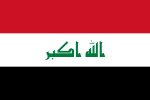Electricity sector in Iraq
| Iraq: Electricity sector | ||
|---|---|---|
 |
||
| Data | ||
| Electricity coverage(2006) | 00%(total), 00%(rural);(Iraq total average in 2007: 00%) | |
| Installed capacity(2011) | 9.0 GW | |
| Share of fossil energy | 81% (thermal, gas) | |
| Share of renewable energy | 19% (hydro) | |
| GHG emissions from electricity generation (1994) | 0.00 t CO2e per capita | |
| Average electricity use (2003) | 700kWh per capita | |
| Distribution losses (2005) | 00%; (Iraq average in 2005: 00%) | |
| Residential consumption (% of total)(2002) | 48% | |
| Industrial consumption (% of total)(2002) | 29% | |
| Government consumption (% of total)(2002) | 13% | |
| Average residential tariff (US$/kWh, 2006) | 0.000; (Iraq average in 2005: 0.000) | |
| Average industrial tariff (US$/kWh, 2006) | 0.000,(Iraq average in 2005: 0.000) | |
| Investment in electricity (post 2003) | US$4.5 billion | |
| Share of Government financing (2004) | 00% | |
As of June 2013, the output of electricity sector in Iraq averages more than 10,000 MW, while the demand is typically more than 14,000 MW. As of January 2016, the figures are output of 13,000 MW and demand of 21,000 MW. In 2006, the average peak electricity supply was 4,280 MW falling short of demand averaged 8,180 MW by about 3,950 MW. According to U.S. agency officials, demand for electricity has been stimulated by a growing economy and a surge in consumer purchases of appliances and electronics. In addition, electricity is subsidized in Iraq, which leads to increased demand.
Iraq's electricity infrastructure consists of a network of
Electricity entered Iraq for the first time in 1917 where the first electric machine was installed in "Khan Dala" building.
Prior to the Gulf War, the total installed generating capacity was 9,295 MW with a peak demand of about 5,100 MW. Approximately 87% of the population had access to electricity. A combination of wars, sanctions, looting and vandalism has however, severely affected the entire power system infrastructure in Iraq.
During the 1991 Gulf War the electricity system suffered severe damage. Several transmission lines were put out of service, substations were damaged. While some of the damage of the 1991 war was repaired and about 4,500 MW of generating capacity was available in 1999 when Iraq reorganized its electricity sector. The sector was separated from the Ministry of Industry, and the Commission of Electricity (CoE) was established on June 21, 1999. About 4500 MW of generating capacity became available by the end of 2002, power supply remained insufficient and unreliable. Programmed load shedding and unplanned power outages were frequent.
Although the power system was not significantly affected by the last conflict, capacity was reduced to approximately 3,300 MW by a combination of further breakdowns, lack of spares and interruption of major maintenance cycles. The balance between generation versus demand as reported on 18/July/2004 by the PCO (Agency responsible for Coalition projects following the CPA, which completed its mandate as of 30/June/2004) is as follows:
...
Wikipedia
